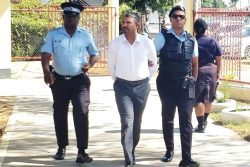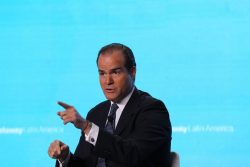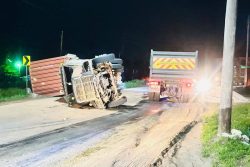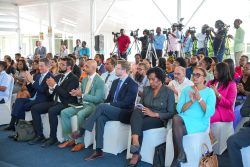Of all the major projects being undertaken by the current government, a new Demerara Harbour Bridge is probably the most transformative and impactful on a personal and daily level to a large portion of the Guyanese public.
Yes, offshore gas might bring cheaper and more reliable electricity (if the country wide transmission system is also sorted out) but for the occupants of the roughly 15,000 vehicles that daily traverse the current ageing metal structure, nothing would transform their lives more than a new bridge. Gone would be the millions of man hours wasted sitting in traffic, the anxiety over openings, and the impediment to the commercial and industrial development of the West Demerara. President Ali is understandably keen to see this completed quickly. Other projects aside, this one is a genuine “no brainer” and one that has been needed for probably 20 years or more.
However, it is troubling to see that the initial approach by the government to the project appears to have significant issues which could work against a timely or cost efficient completion. We will not get into the decision for the location of the new bridge which was moved from the proposed site at Houston, other than to say community discussions on this would have been helpful for those affected but also for the government which needs to think more about methods to get public opinion for its projects and programmes on its side. Consultations are not a favour but an obligation to the citizenry (and they can be smart politics).
Nor will we ask – in the context of the trifling principle of transparent government – what the tolls might be…..$1000 for a regular vehicle? $2500 for a “middle class” SUV?! There may be protests to rival the parking meters weekly socials! We will cross that bridge when the time comes.
The three main issues surrounding the new bridge were highlighted in a Stabroek News article dated June 27 which referred to the original bid documents.
Perhaps most worrying is the lack of any existing geotechnical studies of the riverbed to guide bids and arrive at a design that gives a rough estimate of bills of quantity. The most important and most expensive part of any bridge is the foundation – the pillars that will support the span. Building on the coast of Guyana can be difficult because of its uncertain geology. Under the current bid documents, each company is going to be very unsure as to how to cost the foundation work. How deep must the pillars go? 90ft? 120ft? As it now stands it is pure guesswork and the natural tendency of any company will be to overestimate the costs when bidding. So what happens if the depth of the foundations is less? The contractor makes a windfall gain and the government will have overpaid by many millions of dollars. The difference on a project that might cost around US$350M-$400M could be as high as US$100M. Conversely if the foundations end up costing more, a contractor will either have to eat the extra costs or ask for a renegotiation – a costly and tangled process that could delay the project. A way to get around this uncertainty would be to invite bids based on unit costs. One should recall that the problems at the botched CJIA expansion project have their inception in the lack of a geotechnical study for the extension of the runway on the north eastern side next to the Demerara River. Having discovered too late the area was bagasse, this led to a significant portion of the US$130M Exim Bank loan paying for a massive pile of sand, and leaving less to pay for a brand new terminal. Just for the record, the ten-year anniversary of the signing of the contract with China Harbour Engineering Company comes up on November 11.
When it comes to the bridge the bid documents state it must be completed in 24 months from the date of signing. To enforce this, a penalty of US$25k for every day it goes over the deadline will be imposed. As it stands, the date for submission of the bids has been pushed back at the request of contractors to October 5th. It will likely be April 2022 when a company is identified and that is when the 24-month clock starts ticking. However before even starting construction, the contractor has to mobilise equipment, suppliers and workers, and build a staging area. That will take six months. At the same time the company has to investigate the riverbed to determine the depth and design of the foundations, a process that would take probably nine months. That would leave only 15 months for construction. It is an impossible task. However it may well be that the government by including this unrealistic deadline wanted to impress upon the bidders the need for speed, and that come an actual signing of a contract it will be quietly adjusted. President Ali’s approach to projects as a minister was to set tight deadlines and push hard to meet them, so his style may be reflected in the documents. However, wishing something be done on time does not mean it can physically happen.
The final issue has to do with the requirement that the contractor find financing for the project rather than the government. Right now Guyana with its prospects for oil revenues in the years to come has access to relatively low interest financing. So it is hard to understand why the government does not arrange financing for the bridge at a cheaper rate than most companies could obtain thereby reducing the cost of the project. One can only guess there is a bigger plan to issue government bonds and they would prefer not to have such a loan as a liability on the books. This requirement also strongly favours Chinese companies which already dominate the pre-qualified list of bidders. This is because access to financing is relatively easy through their government which takes into consideration its geopolitical footprint and interests in the region. In all likelihood it will be one of the Chinese firms that wins the bid.
There is of course a strong political aspect to this project. Its completion, even with delays, looks targeted to be before any 2025 election. All things being equal, that single piece of infrastructure could be a powerful boost for the PPP/C’s bid for another five years in power. Conversely the stumps of pillars of a half finished project mired in controversy and even litigation would be a powerful symbol of the government’s failure to deliver for the 100,000 plus constituents of Region Three. Commuters whizzing across a brand new bridge would provide a massive political boost. Commuters stuck in traffic as the old bridge creaks beneath them? A major political risk and a personal setback for the President. The government must proceed cautiously for the sake of the country.








